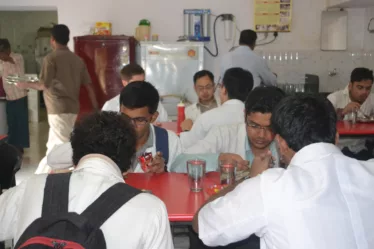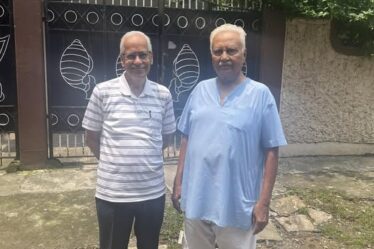It was a typical Thursday, my OPD day. After completing rounds, I settled into the clinic, surrounded by my medical residents. The waiting hall buzzed with life, crowded with patients, many standing near the door, each waiting their turn. Mornings like these felt routine, but they never lacked purpose. Our hospital, a beacon of hope for rural patients, is where many find care they can’t afford elsewhere. Here, we don’t just treat; we teach.
The OPD is where residents learn that Medicine isn’t just a science; it’s also an art.
I had just finished explaining how to approach patients with acute unexplained fevers when she entered—a 24-year-old mother of two, her eyes full of life yet clouded with fear. “I have a hole in my heart,” she said, her voice trembling. “Can you fix it, sir?”
She clutched a battered file, the edges warped from the rains—smudged ink, crumpled papers, the faint musty scent of dampness. Inside, there were two crumpled, handwritten discharge summaries with fading ink, a nearly illegible ECG strip, a creased chest X-ray sealed in a yellowing envelope, and a damp, stained echo report.
Her husband stood beside her, holding the file with trembling hands. “Doctor, please look at this first,” he said, urgency in his voice.
I gently set the file aside. “We’ll come to that,” I reassured him, meeting her anxious gaze. Sometimes, the story a patient tells is more revealing than the one written in their file.
I listened as she shared her story. Diagnosed with an atrial septal defect after her first childbirth, she reported no breathlessness, chest pain, palpitations, or swelling—just the lingering worry over what the diagnosis meant.
Despite the defect, she appeared remarkably well. Her pulse was steady, blood pressure normal, feet un-swollen, breathing effortless, lungs clear. Her neck veins lay flat, showing no signs of pressure. Her body seemed at ease, hiding the condition within, as though shielding her from fear.
But as I leaned closer, her heart revealed its secret: a soft murmur, faint yet distinct. The second heart sound split widely, its two components perpetually apart, like doors left ajar in quiet defiance, hinting at the unseen defect.
“Are you sure her heart condition was only discovered after marriage and pregnancy?” I asked gently.
Her husband, standing beside her, his hand on her shoulder, replied, “Her parents were poor and uneducated. They didn’t know. We found out only when she was pregnant.”
Two pregnancies later, she had sailed through both without complication. Her heart remained steady despite unnoticed strain. She had required no medications, and her daughters—four and two—were her world. Now, with a glimmer of hope from a cardiac surgeon, they saw a chance to fix what had been broken for so long.
The surgeon arrived—confident, calm, kind. Reviewing the results, he said, “It’s a simple hole in the heart. The surgery is straightforward. She’ll likely wake up right after, and be home by the weekend.”
His reassurance filled the room with hope. The procedure seemed routine—another day’s work for a seasoned surgeon.
On surgery day, the operating room was focused and quiet. Her husband waited outside, holding his phone, pacing but remaining still. Inside, the team worked swiftly and carefully.
The surgeon made the incision, and the heart-lung bypass machine seamlessly took over. With steady hands, he carefully sutured the hole—about the size of a small coin—sealing the defect with precision.
“I’ll be done in less than three hours,” he had reassured us. Three hours passed. Then four. Four stretched into five. Something was wrong.
Anxiety crept in. Each passing minute grew heavier, time itself seeming to stretch.
Finally, the surgeon emerged. His face said it all—pale, exhausted. His voice trembled. “I’m so sorry. We did everything we could, but… air got into her brain during the surgery.”
He paused, explaining. “The oxygenator—the machine that keeps blood flowing—ran low on blood. The level dropped too much, and under pressure, the perfusionist missed it. Air got into her arteries and went to her brain. We tried, but there was nothing we could do.”
He took a deep breath and spoke softly, “Her heart’s still beating, but… her brain is gone.”
The room fell silent, heavy with sadness. How could this happen? A simple surgery. A young mother. Two daughters waiting at home.
Her husband collapsed into a chair, crying. The nurses cried too. Even the perfusionist, who had made the mistake, cried. I stood frozen, unable to speak or cry.
Doctors are trained to act, to search for answers, not to feel. But in moments like this, all that training feels empty. How do you measure the loss of a life full of hope?
The surgeon visited the family, preparing them for the worst. He admitted his error, and to his relief, the husband placed the blame on destiny rather than on his hands.
The next day, she passed away. We waived the hospital charges and arranged transport, but those gestures felt hollow. What could possibly console a man who had lost his wife? How do you comfort children too young to understand why their mother wasn’t coming home?
I stood frozen, speechless, unable to shed a tear. We had tried, but it wasn’t enough. Despite the hope we had clung to, we had failed.
Weeks passed, but her memory lingered. It surfaced quietly, catching me off guard. I thought I had moved on. Then one evening, while sitting with my sister—ten years older—and my wife, the grief came crashing back.
The tears came suddenly, as if they had been waiting. I cried like I hadn’t in years. Just an hour earlier, I was laughing with them. The house felt warm, full of life. Now, the room was still, the lightness gone, replaced by an unbearable silence.
They watched, stunned. My sister’s eyes widened. Her hand hovered near my shoulder, unsure. My wife sat motionless, mouth slightly open, struggling for words. Neither had seen me like this before. After what felt like forever, my sister placed a hand on my shoulder. “What’s wrong?” she asked gently.
Through my sobs, I managed, “I lost a young mother a few weeks ago.” My voice cracked. “She came in with so much hope, and I couldn’t save her. Now her daughters are without her.”
The words cut deep. “Those little girls… they’ll never know their mother because of us.”
It wasn’t just guilt—it was helplessness, regret, and the crushing weight of knowing that sometimes, despite everything we do, we still fail.
Doctors aren’t supposed to cry—or so we’re told. We’re seen as strong, the last hope. We project confidence—not just for our patients, but for ourselves.
But behind closed doors, we do cry. We’re trained not to, yet we do. We cry for the lives we couldn’t save, for the families left behind, for the mistakes that linger.
In the days following her death, I replayed every detail. I consulted heart surgeons, studied cases of air bubbles during surgery. Could we have done something differently? Was there a sign we missed? These questions lingered, casting shadows in quiet moments.
Textbooks, case studies, experienced surgeons all agree: ‘Even with the best care, things like this can—and do—happen. But they are rare.’
How do you cope with the weight of a life lost? That day, I cried because I thought of her daughters—two little girls waiting for a mother who would never come back. I cried because I couldn’t escape the feeling that I had failed her. I cried because I cared, and sometimes, caring is what breaks us.
But we carry on. We return to the hospital, to the operating rooms, to the clinics. We smile, comfort, and reassure. Because we must. If we let the tears take over, they might never stop.
Medicine is full of contradictions. It empowers us, yet makes us vulnerable. We save lives, but we also lose them. We perform miracles, but we’re not immune to tragedy.
In the end, we’re not just doctors—we’re human beings. And sometimes, the weight of that care becomes unbearable, like a heart strained by a hidden defect.

